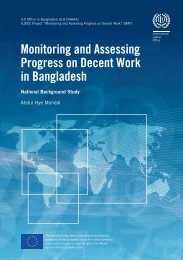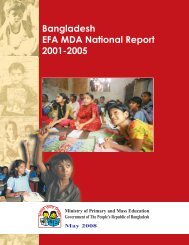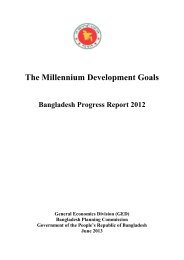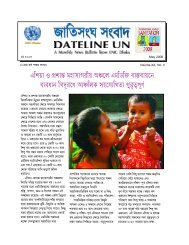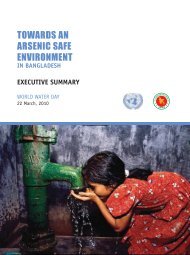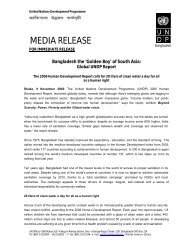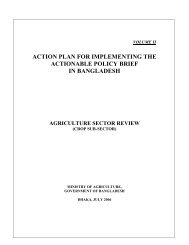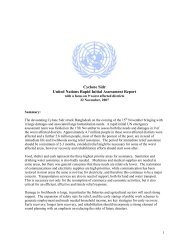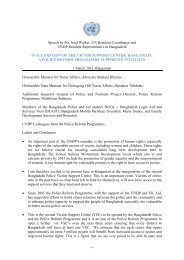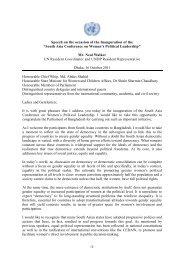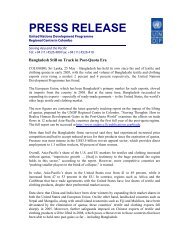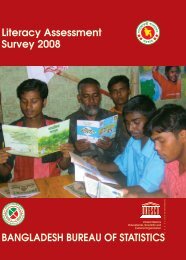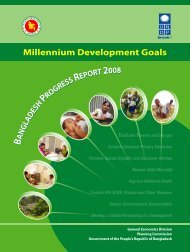STATE OF WOMEN IN CITIES 2012-2013 - UN-Habitat
STATE OF WOMEN IN CITIES 2012-2013 - UN-Habitat
STATE OF WOMEN IN CITIES 2012-2013 - UN-Habitat
You also want an ePaper? Increase the reach of your titles
YUMPU automatically turns print PDFs into web optimized ePapers that Google loves.
<strong>STATE</strong> <strong>OF</strong> <strong>WOMEN</strong> <strong>IN</strong> <strong>CITIES</strong> <strong>2012</strong>-<strong>2013</strong><br />
Figure 1.2.1<br />
Correlation 1 between SIGI and percentage of the world’s MDP<br />
SIGI Score<br />
equalty inequality<br />
SIGI versus Percentage of the<br />
world’s MDP<br />
0.6<br />
0.5<br />
MDP<br />
0.4<br />
Linear (MDP)<br />
0.3<br />
R 2 =0.430<br />
0.2<br />
0.1<br />
0<br />
0 0.2 0.4<br />
Percentage of the world’s MDP<br />
SIGI Score<br />
equalty inequality<br />
0.6<br />
0.4<br />
0.2<br />
SIGI versus Percentage of<br />
the world’s MDP<br />
[excluding LAC & MENA 3 ]<br />
MDP<br />
R 2 =0.430<br />
0<br />
0 0.2 0.4<br />
Percentage of the world’s MDP<br />
Sources: Chant and Datu (2011a), OECD (2009), <strong>UN</strong>DP (2010)<br />
Notes:<br />
1. Correlation should not be confused with causation. A strong correlation suggests two variables are related, but does not imply that a change in one will automatically induce a<br />
change in the other.<br />
2. The R 2 value is a measure of the linear correlation of the variables. A value of 0 indicates no relationship while 1 indicates a perfect linear relationship.<br />
3. LAC refers to Latin America and the Caribbean, MENA to Middle East and North Africa<br />
Women returning home with laundry, Mexico.<br />
© <strong>UN</strong>-<strong>Habitat</strong><br />
These include a quantification of gender-differentiated<br />
domestic labour and care burdens, as well as registration<br />
of women’s paid work because of its concentration in the<br />
informal economy. 26 Although major progress in improving<br />
the quality of sex-disaggregated statistics has been made,<br />
the lack of gender indicators in all MDGs, and the limited<br />
nature of MDG 3 targets for women compared with the<br />
Beijing Platform for Action (BPFA) of 1995 have provoked<br />
widespread debate and critique. 27<br />
In terms of actual data available, it is not only rare for<br />
data to be sex-disaggregated, but for statistics to be available<br />
for different groups of women (or men) beyond household<br />
headship, for example, along lines of age, ethnicity, migrant<br />
status, sexuality and so on. 28 There are also cases where<br />
relatively little is known about more basic aspects of gender<br />
and urban prosperity, which are technically amenable to<br />
measurement, such as gender differences in land and property<br />
ownership. 29 Data are also scarce in terms of comparing<br />
women and men in relation to urban prosperity in the<br />
wealthier and poorer parts of cities, which usually correspond<br />
with ‘non-slum’ and ‘slum’ settlements respectively. 30 Even<br />
less still is known about transient populations in the city, and<br />
those who live or spend the vast majority of their time ‘on the<br />
streets’. 31<br />
22



